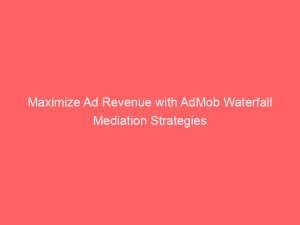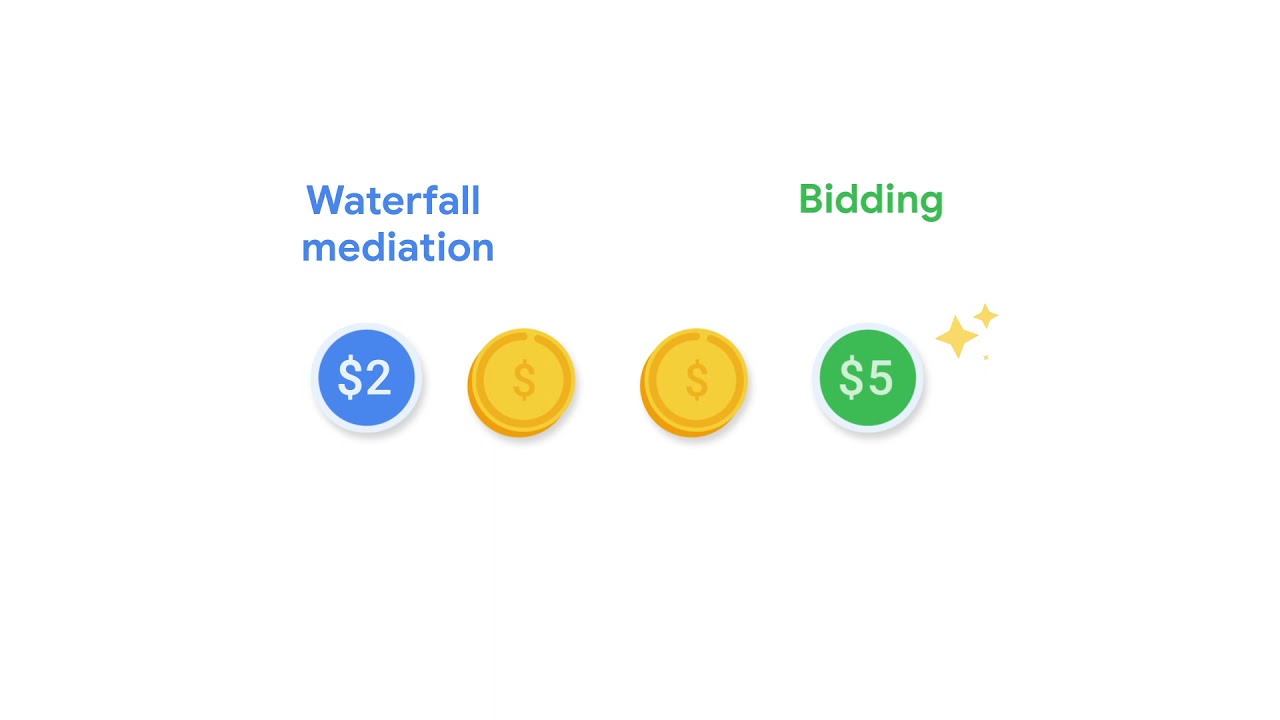- admob waterfall
- 1. Manual eCPM Input or Dynamic Ordering
- 2. Steps for Setting Up a Waterfall Ad Source
- 3. Optimization in AdMob’s Mediation Waterfall
- 4. Turning On Optimization for eCPM Adjustment
- 5. Gathering Historical eCPM Data from Third-Party Ad Sources
- 6. Ad Networks Supporting Optimization on AdMob
- 7. Timing and Process of Optimization
- 8. Reviewing Optimized Average eCPM on Mediation Group Page
In the ever-evolving landscape of mobile advertising, a powerful tool called AdMob has emerged as a game-changer. With its innovative waterfall ad source feature, AdMob takes optimization to a whole new level.
Picture this: you can manually or dynamically input eCPM values based on historical data, allowing AdMob to optimize the placement of ad sources in the waterfall. But that’s not all.
AdMob goes a step further by analyzing historical eCPM data from third-party sources and offering optimized solutions. It may take a few days, but the results are worth the wait.
And that’s not even the best part! AdMob Network also offers real-time eCPM bidding and optimization.
Twice a day, average eCPM metrics are observed, optimized, and ready to boost your revenue. Get ready to dive into the world of AdMob Waterfall and unleash the power of mobile advertising like never before!
| Item | Details |
|---|---|
| Topic | Maximize Ad Revenue with AdMob Waterfall Mediation Strategies |
| Category | Ad Networks |
| Key takeaway | In the ever-evolving landscape of mobile advertising, a powerful tool called AdMob has emerged as a game-changer. |
| Last updated | December 27, 2025 |
admob waterfall
AdMob waterfall is a feature in AdMob that allows users to set up a waterfall ad source. The process involves either manually inputting eCPM or using dynamic ordering based on historical data.
To set up a waterfall ad source, users need to sign in to their AdMob account, access the Mediation section, go to the Waterfall sources tab, select the desired ad source, enter credentials, authorize access, and add ad unit mapping details. Once the waterfall is set up, users can optimize it by turning on optimization, which allows AdMob to adjust eCPM based on historical data.
AdMob gathers the ad unit’s historical eCPM data by calling the third-party ad source’s API. Optimization is available for certain ad sources, and a list of third-party ad networks that support optimization can be found on the AdMob website.
It is important to note that the optimization process may take up to 3 days. Additionally, AdMob offers the option to optimize its own network with real-time eCPM bidding.
The optimization process uses two metrics: Observed eCPM (estimated average eCPM) and Optimized average eCPM (used for determining the ad source’s placement in the waterfall). The Optimized average eCPM is updated twice a day using historical data, and users can review it on the mediation group page.Key Points:
- AdMob waterfall allows users to set up a waterfall ad source in AdMob.
- Users can manually input eCPM or use dynamic ordering based on historical data.
- Setting up a waterfall ad source requires signing in to AdMob, accessing the Mediation section, and going to the Waterfall sources tab.
- Users need to select the desired ad source, enter credentials, authorize access, and add ad unit mapping details.
- Optimization can be turned on to allow AdMob to adjust eCPM based on historical data.
- The optimization process uses Observed eCPM and Optimized average eCPM metrics, which are updated twice a day using historical data.
Sources
https://support.google.com/admob/answer/13404328?hl=en
https://support.google.com/admob/answer/7374110?hl=en
https://support.google.com/admob/answer/9234488?hl=en
https://stackoverflow.com/questions/73399923/do-we-need-to-add-waterfall-source-in-google-admob-mediation
Check this out:
💡 Pro Tips:
1. Use real-time eCPM bidding for optimizing AdMob Network: Optimize your AdMob Network by enabling real-time eCPM bidding. This allows AdMob to adjust the eCPM based on real-time data and maximize your ad revenue.
2. Check the list of third-party networksad networks supporting optimization: Before adding ad sources to your AdMob waterfall, make sure to review the list of third-party networksad networks that support optimization on AdMob’s website. This will help you choose the right ad sources for your mediation.
3. Understand the metrics: Familiarize yourself with the metrics used for optimization in AdMob’s mediation waterfall. The two important metrics are Observed eCPM (estimated average eCPM) and Optimized average eCPM. Understanding these metrics will help you track and evaluate the performance of your ad sources.
4. Give optimization process time: Keep in mind that the optimization process in AdMob may take up to 3 days. Be patient and allow AdMob to gather and analyze the historical eCPM data from third-party ad sources before expecting significant changes in your ad waterfall.
5. Regularly review Optimized average eCPM: Make it a habit to regularly review the Optimized average eCPM on the mediation group page in AdMob. This will help you monitor the performance of your ad sources and make necessary adjustments to maximize your ad revenue.
1. Manual eCPM Input or Dynamic Ordering
When it comes to setting up a waterfall ad source in AdMob, you have the option to either manually input the eCPM (effective cost per thousand impressions) or use dynamic ordering based on historical data.
The choice between the two depends on your preference and understanding of your ad inventory’s performance.
Optimized content based on recent advertiser behavior.
2. Steps for Setting Up a Waterfall Ad Source
To set up a waterfall ad source in AdMob, follow these steps:
Sign in to your AdMob account.
Access the “Mediation” section in the navigation menu.
Click on the “Waterfall sources” tab.
Select the desired ad source from the available options.
Enter the necessary credentials for your chosen ad source.
Authorize AdMob to access the ad source on your behalf.
Add the ad unit mapping details to ensure proper integration between AdMob and the ad source.
3. Optimization in AdMob’s Mediation Waterfall
Optimization plays a crucial role in maximizing ad revenue within AdMob’s mediation waterfall.
By turning on optimization, AdMob can automatically adjust the eCPM based on historical data. This ensures that the most efficient and profitable ad sources are given priority in the waterfall.
4. Turning On Optimization for eCPM Adjustment
To enable optimization in AdMob’s mediation waterfall, you need to activate the feature within the settings of your ad units.
AdMob utilizes historical data to gather the ad unit’s eCPM information by calling the third-party ad source’s API. This process helps AdMob identify the best performing ad sources and adjust their placement accordingly.
5. Gathering Historical eCPM Data from Third-Party Ad Sources
AdMob gathers historical eCPM data from third-party ad sources through their API integration.
This data is crucial in identifying the performance of each ad source and determining their placement within the waterfall. By understanding the historical eCPM data, AdMob can optimize the waterfall to ensure the most profitable ads are prioritized.
6. Ad Networks Supporting Optimization on AdMob
AdMob provides optimization support for select ad sources within its mediation platform.
To find out which ad networks support optimization on AdMob, you can refer to the list available on AdMob’s website. This list helps you identify the ad networks that are compatible with AdMob’s optimization strategies.
7. Timing and Process of Optimization
After enabling optimization for an ad unit, AdMob’s system begins collecting and analyzing historical data to refine the eCPM adjustments.
The optimization process may take up to three days to ensure accuracy and reliability. During this period, AdMob evaluates the performance of the ad unit and adjusts the eCPM accordingly to maximize ad revenue.
8. Reviewing Optimized Average eCPM on Mediation Group Page
To track the effectiveness of optimization strategies, AdMob provides a simple way to review the optimized average eCPM.
This metric is calculated based on historical data and is updated twice a day. By reviewing the optimized average eCPM on the mediation group page, you can gauge the performance of each ad source and make informed decisions about their placement in the waterfall.
In conclusion, AdMob’s waterfall mediation strategy allows you to optimize ad revenue by incorporating eCPM adjustments based on historical data. By following the step-by-step setup process, utilizing optimization options, and reviewing the optimized average eCPM, you can maximize your ad revenue potential.
Make use of the available features and keep an eye on the performance of your ad sources to ensure your app’s monetization efforts are successful.
Performance Marketing Tips • Programmatic Advertising • Advertising Platform for Marketers • Native Ad Network











